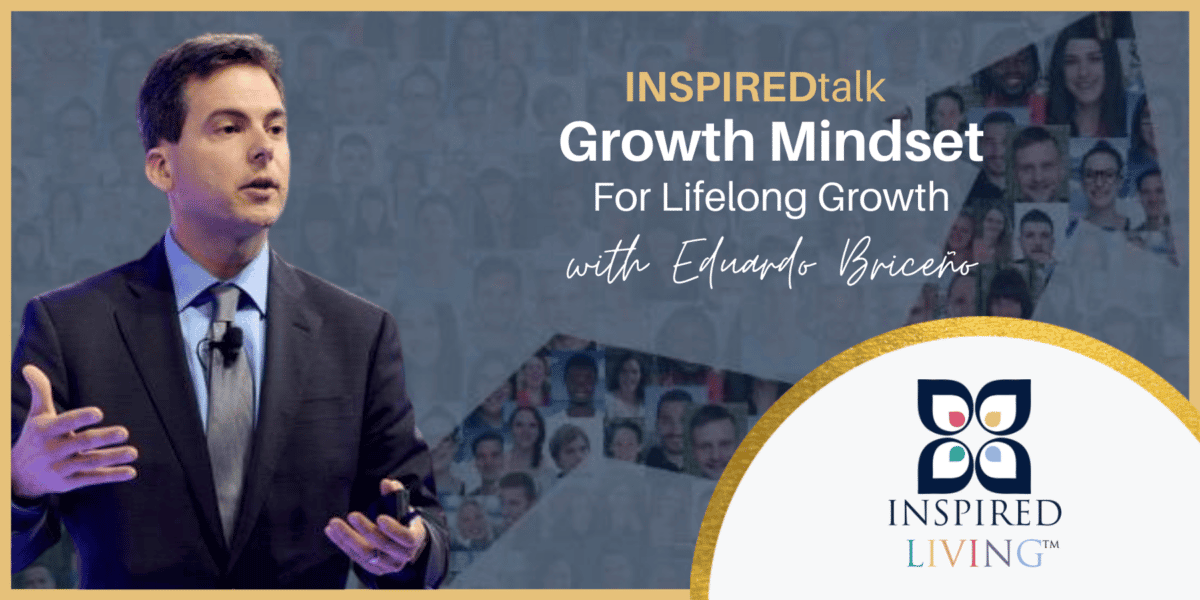
On Thursday, July 7, 2022, Mission Wealth hosted our seventh INSPIREDtalk where we heard from author and TEDxTalk Speaker Eduardo Briceño explain what and why a growth mindset is important and how to shift our current way of thinking.
Fostering a “growth mindset” has never been more important than now. The world is changing at an incredibly fast pace and there are new challenges we must face every day - whether at home, at work, or even when entering in a new chapter of life.
Watch Eduardo Briceño's INSPIREDtalk
What is a growth mindset?
A growth mindset is when we believe that we can change and other people can change. It is when we view our abilities and our qualities as malleable and tangible as things we can change over time.

In comparison, a fixed mindset is when we believe that intelligence is something that is fixed in people, either high, medium, or low. We think that some people are numbers people and others aren't, whereas a growth mindset tells us someone can continue to become better at working with numbers.
This is important because is we want to improve in something, we have to change. Often times, we like the idea of getting better, but not the idea of change. Recent research has also showed that this belief affects our behaviors, which ultimately affects our outcomes.
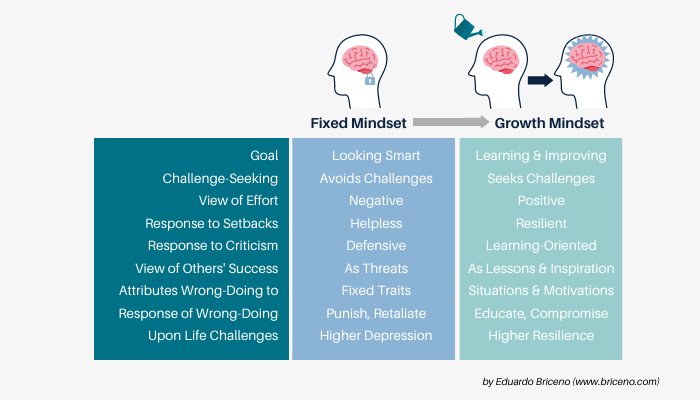
A fixed mindset is a part of being human; you can't just banish the fixed mindset, you have to take the journey. We can do this by becoming more aware of this mindset and how it affects us.
Learning Zone vs. Performance Zone
Often times when we see professionals or successful individuals, we don't see why they are so good. For example, an acrobat may be flawless in their performance, with no mistakes. But we often don't see how they are so good at their practice and how often they practice.
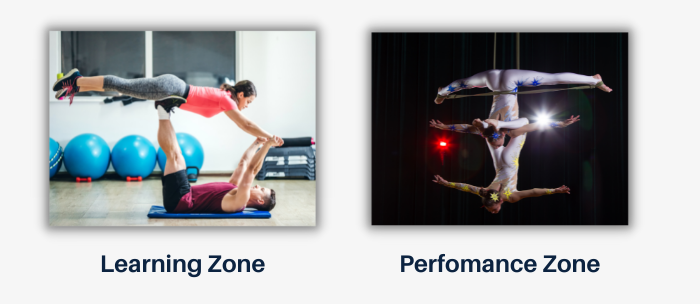
In a Learning Zone, these acrobats are in the studio or gym, missing the bar, falling, and making mistakes. Because of the time they spend in the Learning Zone, making mistakes and trying new things, it enables them to succeed in the Performance Zone.
It is what we do in the Learning Zone, working on what we don't know and what we haven't mastered that enables us to excel in the Performance Zone. So many times, we get stuck in the Performance Zone in work and life, always trying to do our best, minimizing mistakes, and this can lead to stagnation.
No matter which zone you make a mistake in, we want to respond in a learning oriented way - what can I learn from this mistake? What can we do differently going forward? A growth mindset helps us in both zones by understanding that we can get better.
How regularly do you do the following?
- Set learning/improvement goals
- Explore the distant, the unknown, the new
- Access learning resources (books, courses, videos)
- Experiment or try new ways of working/living
- Observe or consult with others
- Assess and reflect
- Examine/discuss mistakes or surprises, to learn
- Solicit, give, and receive open and honest feedback
- Consider being wrong
- Speak with others about how to learn/improve
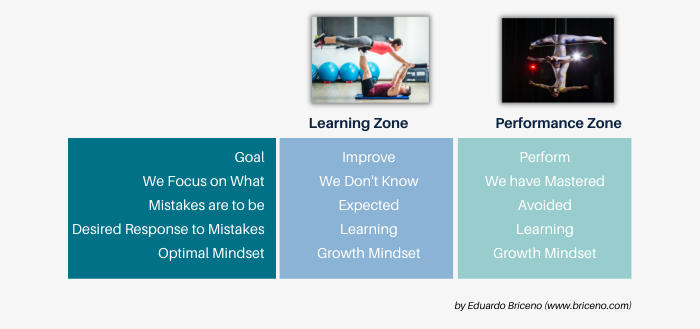
Often times when we make a mistake, we think there will be negative consequences and that others will think less of us. However, if we’re thinking that way, we will spend all of our time trying to minimize mistakes in the performance zone, which will lead to stagnation. Instead, we need to build social networks that value challenge, feedback, and growth, rather than perfection. Without that, we will get stuck in chronic performance.
Are you creating a sense of safety by encouraging those around you to take on challenges and make mistakes? You can help create this safe space with the following:
Framing: how do you frame things for yourself and for others? Do you explain that part of what we want to be doing every day is challenging ourselves with hard things we can’t do perfectly so that we can improve?
Systems and Habits: what systems and habits are you engaging in your daily life in order to always continue to improve? Effective systems and habits are what make continuous growth possible.
Modeling Learning: are we modeling learning visibly to others? Our actions are important if we're saying that learning is important, we need to follow that with actions. When we portray ourselves as works-in-progress and show that we strive to improve, we inspire others to continue to evolve as well.
How regularly do you visibly do these?
- Identify skills I want to improve and share them
- Take on worthwhile challenges and risks I can learn from
- Try something new or experiment
- Ask questions to which you don't know the answer
- Answer, "I don't know" or "What do you think?"
- Solicit and process feedback
- Discuss mistakes to learn
Growth Mindset and Aging
Research shows that we can be in one of two mindsets when it comes to aging. We can see aging as debilitating, or we can believe that anyone can thrive at any age. Like other mindsets, we often acquire our beliefs on aging from the world around us, and often times from media. And although in Western societies, a debilitating belief is more common, shifting your mindset can have shocking outcomes.
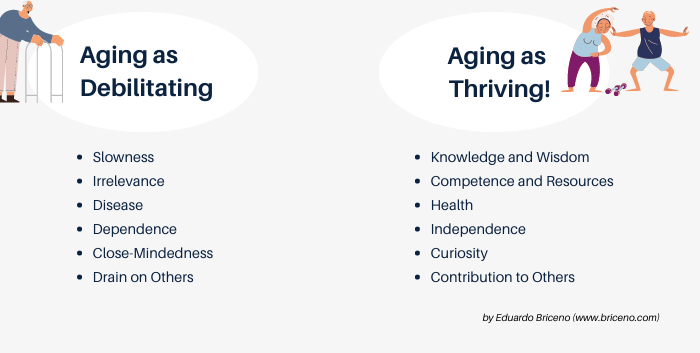
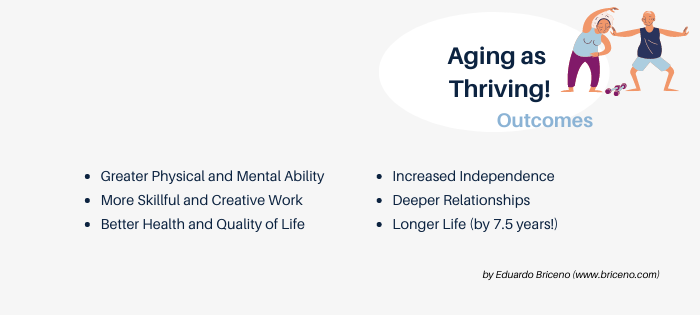
For more information on how this mindset and how we can develop more adaptive and more positive beliefs on aging, check out the book Breaking the Age Code by Becca Levy, PhD.
Q&A with Seth Streeter and Eduardo Briceño
I'm still early in my career, how can I use a growth mindset instead of a fixed mindset to help me grow? Whether you are early in your career, later in your career, or even entering into retirement, start by being mindful about what we're seeking to improve. Then, how are you going to get better at that - what are the learning zone strategies that are going to be helpful for you. Most importantly, solicit feedback from those around you, peers, management, family, and friends.
My last business failed after about three years and I am trying to think about my next moves in life. How do I incorporate a growth mindset after a failure like this? Learning from your mistakes and your failures is critical and as Oprah said, is a key way to learn and think. We want to have failures often and less impactful, so we want to be experimenting often and creating lots of small failures to learn from (instead of making big experiments every 10 years). Whether large or small, reflect on the mistake to identify what to do differently. For the next move after a failure, continue pursuing what you are passionate about, with the increased wisdom you’ve gained from reflecting on your mistakes. The process of growth, and the actual improvement and increased impact achieved, generates more fulfillment.
How do you discuss a growth mindset with family members who are stuck in fixed mindsets? The key is to start with ourselves. The best way to get others to start adapting to more of a growth mindset is to start by visibly doing so yourself. Think about how you frame what life and work is about, what systems and habits you encourage, and how you model. We can also always plant seeds; don't try and change someone else, but plant seeds of change.
How do we identify when we are in a fixed mindset? Think of the responses that are associated with a fixed mindset, such as reacting defensively to feedback, shying away from challenges, or experiencing anxiety. Ask yourself whether a fixed view of abilities might be underneath those symptoms, and whether that view is serving you well.
How has social media impacted the adoption of a growth mindset? Is it good being inspired by others and learning or should we simply focus on our own internal learning efforts? Social media has tended to heighten the kind of comparison factor and majority of the times, shows people as flawless and having a perfect life. But remember that behind every apparent perfection, there is struggle and a growth journey, which we often don’t see. Rather than compare people at a fixed moment on time, focused on our own process of learning and growth.
How can we successfully use life transitions to adopt a growth mindset? A large amount of studies have shown the most effective way and timing for a growth mindset intervention is in a transition. This is a time where our mindset is, in a way, vulnerable, for good and for bad. We’re pondering what shifts we need make to thrive in the next chapter. So we can leverage times of transition to foster a growth mindset by being clear about what we’re working to improve and how.
About the Speaker | Eduardo Briceño
Eduardo Briceño is a global keynote speaker, facilitator, and guide supporting leaders cultivating growth mindset cultures. Prior to that he was the CEO of Mindset Works, the pioneer in growth mindset development services, which he cofounded in 2007 with Stanford professor Carol Dweck, Lisa Blackwell, and others, and led for over a decade. Before that he was a technology investor with Credit Suisse’s venture capital arm the Sprout Group and served on several for-profit and non-profit boards.
Eduardo’s TEDx talk on growth mindset and TED Talk on the learning zone and the performance zone have each been viewed by millions. He is a Pahara-Aspen Fellow, a member of the Aspen Institute’s Global Leadership Network, and an inductee in the Happiness Hall of Fame.
MISSION WEALTH IS A REGISTERED INVESTMENT ADVISER. THIS DOCUMENT IS SOLELY FOR INFORMATIONAL PURPOSES, NO INVESTMENTS ARE RECOMMENDED. ADVISORY SERVICES ARE ONLY OFFERED TO CLIENTS OR PROSPECTIVE CLIENTS WHERE MISSION WEALTH AND ITS REPRESENTATIVES ARE PROPERLY LICENSED OR EXEMPT FROM LICENSURE. NO ADVICE MAY BE RENDERED BY MISSION WEALTH UNLESS A CLIENT SERVICE AGREEMENT IS IN PLACE.
00457268 07/22


